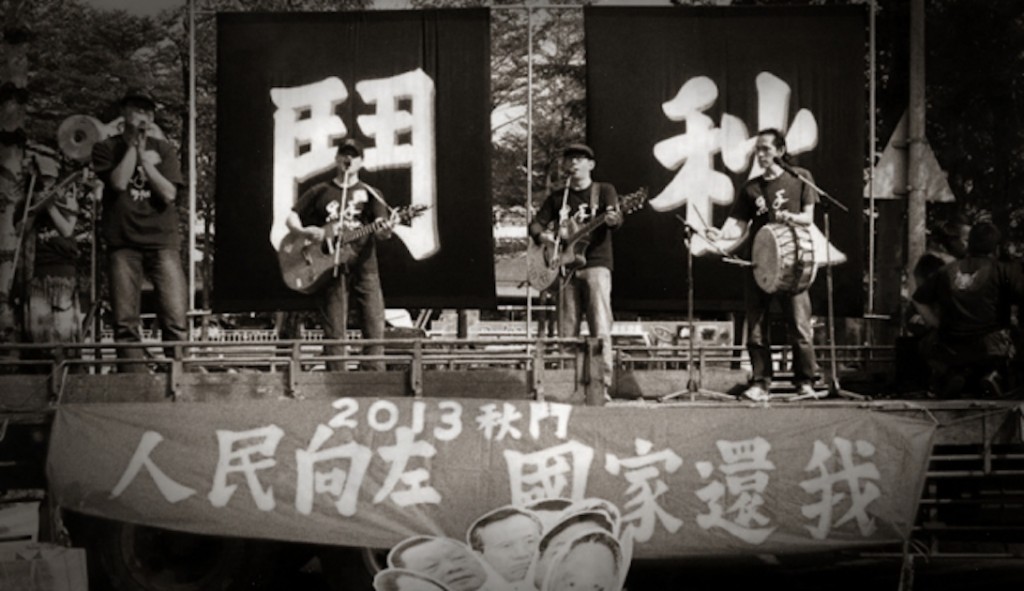最早由ICLE(Informational Center of Labor Education,台灣勞工教育資訊發展中心)及工委會(工人立法行動委員會)的協助下,成立於1996年。底層勞動人民因著教育機會及生活環境限制的緣故,往往被剝奪了掌握音樂、藝術等文化工具的權力。而社會上諸如流行音樂、藝術文化等種種文化表達形式,大都為服務中上階層而產制,而亟需擁有發聲工具的勞動階層,反而僅能由卡拉OK、流行音樂的片斷中,找到表達情感的只字片語。為奪回工人階級與底層弱勢者發聲權利,黑手那卡西以進行工人群眾的音樂、文化教育工作為目標,協助工人與弱勢者用自己的語言,唱出自己的心聲。因此,黑手那卡西不僅是「為運動而服務」的樂隊,更努力在音樂與運動的實踐中,嘗試集體創作的可能,與群眾一起形塑真正屬於工人階級、弱勢者、艱苦人的文化。
黑手過去十幾年來累積的文化協同創作方法,是黑手音樂與社會實踐結合所展現的文化抵抗。協同指涉相互投入為共同目標努力的「對等關係」,並非「擁有專業權威者」與「缺乏條件者」的「上下關係」。文化協作,是具體社會運動與組織的文化鬥爭,展現在歌曲、音樂生產關係和發生過程上,就是「集體創作」,包括抗爭現場主流歌曲的挪用與改編、經過集體討論的創作歌曲、以及團員對於彼此音樂風格的鬥爭與對話。文化協作亦是音樂操作能力的教學對話過程,如工人吉他工作坊、練習團,目的便為使工人、弱勢者得以掌握基本的彈唱發聲能力。
因為黑手協同工人、弱勢者的「主體發聲」,黑手的文化生產並非專業者使用精練的社會分析、文獻、詩詞、演講、音樂等方式所表達的高雅文化,而是一些稍具文化資本的大學生,與蘊含豐富文化內涵卻缺乏文化表現工具的工人,底層人民、受歧視的團體,協同創作與展演出的文化。從關廠抗爭現場、到集體創作、再到工傷音樂工作坊,從工人吉他班,到練習團,到互唱互訪,在黑手那卡西的創作和演出中,清楚看到工人、弱勢者的主體,在文化協作的關係中更有機會出現、發聲。他們不是幫社會運動伴唱,他們就是社會運動的一環。
BlackBlack Hand Nakasi is a workers’ band set up by workers and union organizers in 1996 with assistance of ICLE (Informational Center of Labor Education) and CALL (Committee for Actions on Labor Legislation). As a band involving in social movements in the form of music, Black Hand Nakasi is distinct from mainstream or non-mainstream bands in the sense of social movement meanings conveyed and recurred in their songs.
To obtain the cultural power of the working class and the disadvantaged, Black Hand Nakasi holds that working people at the bottom of the society are often deprived of powers to master music, arts and other cultural tools due to the limitations on their educational opportunities and living environments. Various cultural expressions in society, such as popular music, art and culture, are mostly generated for the upper middle class. The working class, who are in urgent need of sound-making tools, can only find a few isolated words or phrases to express emotions through fragments of Karaoke or pop music. To regain the voicing right of the working class and the disadvantaged at the bottom of the society, Black Hand Nakasi targets the music and cultural education of the working masses, helps workers and the disadvantaged to sing their hearts out in their own languages. That is to say, Black Hand Nakasi is not only a band “serving social movements”, it also tries the possibility of collective creation in practical music production and movements, and, with the masses, attempts to shape the culture that really belongs to the working class, the disadvantaged and people with tough lives.
Cultural collaborations and collective creations: main voices of workers and the disadvantaged
The creative method of cultural collaborations that Black Hand Nakasi has accumulated over the past dozen years is a cultural resistance demonstrated in the combination of Black Hand music and social practices. The collaboration refers not to the “superior-subordinate relationship” between “the ones with professional authority” and “the ones who lack conditions” but to a “peer-peer relationship” of mutual endeavors for a common goal. Cultural collaborations are cultural struggles of concrete social movements and organizations, and are “collective creations” when they are demonstrated in the process of music generation and song production, which include struggles against the appropriation and re-writing of live mainstream songs, song compositions after group discussions as well as struggles and dialogues on music styles of band members. Moreover, cultural collaborations are also teaching and dialogue processes of music operational capability, e.g. workers’ guitar workshops and practice groups, the aim of which is enabling workers and the disadvantaged to master basic playing and singing skills.
The reason why Black Hand’s cultural collaborations are particularly noted is that main voices of Black Hand together with workers and the disadvantaged have special and crucial meanings. The cultural production of Black Hand is different from that of high culture, and is not expressed by professionals who employ precise social analysis and research, or articulate through refined forms of poetry, speeches and music. Instead, it is a culture of collaborative creations and performances made by college students with limited cultural capital and workers who are rich in cultural connotations but lacking in cultural capitals. From sites of closed plants and worker protest, to work injury music workshops, from workers’ guitar classes, to practice groups, then to creations and performances of Black Hand Nakasi, we have clearly seen that the subjectivity of workers and the disadvantaged; we see they are gaining more opportunities to appear and make their voices in the collaborative cultural relationship.
